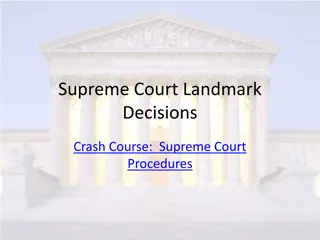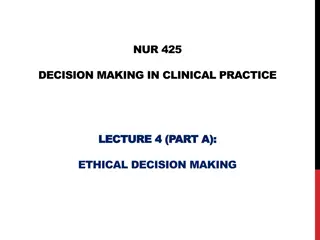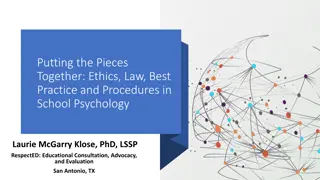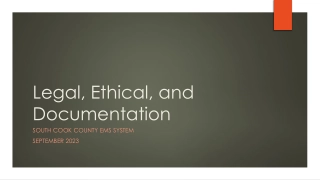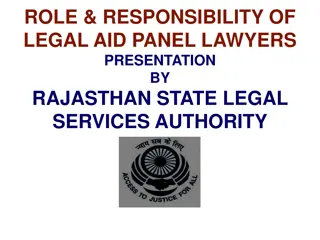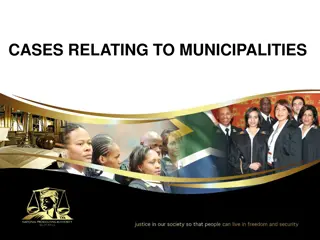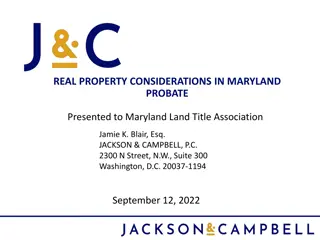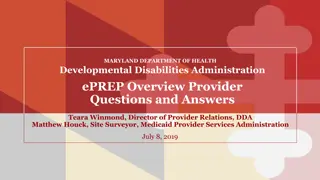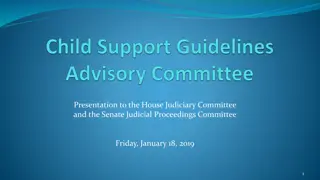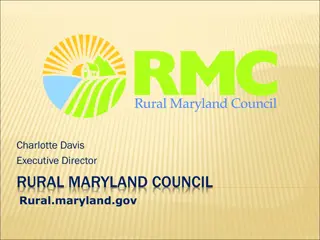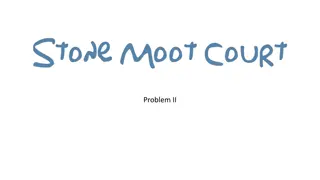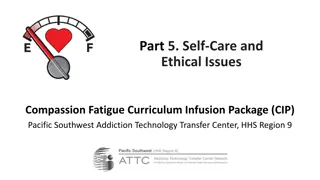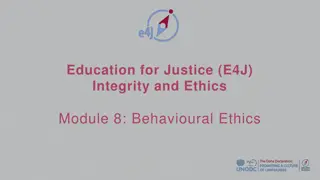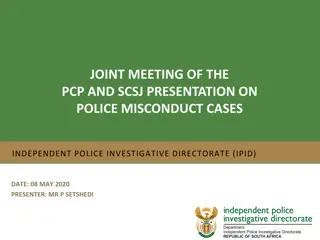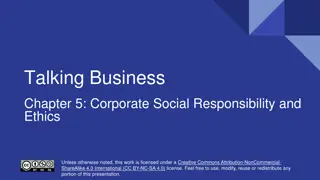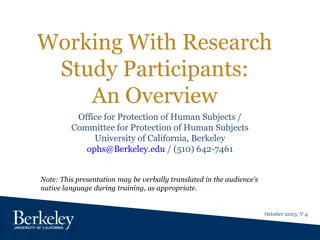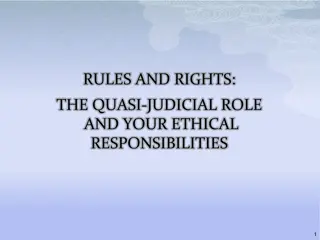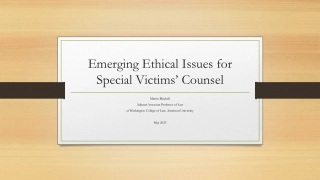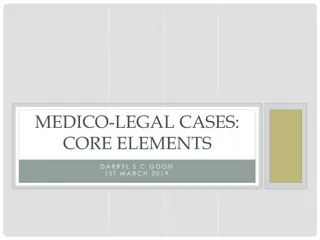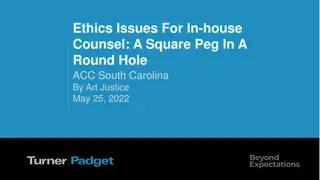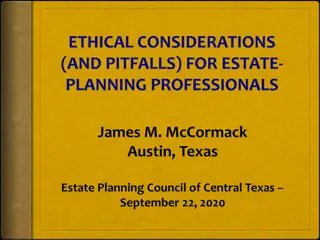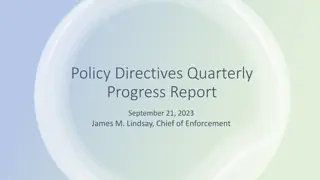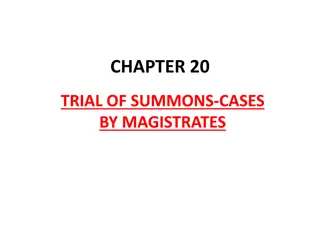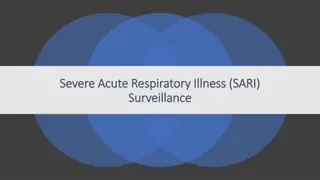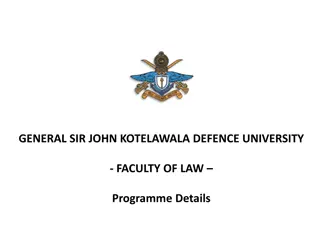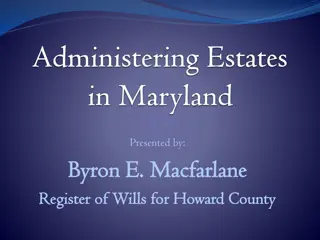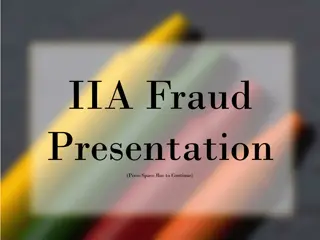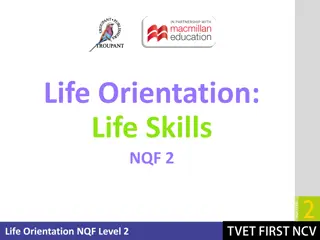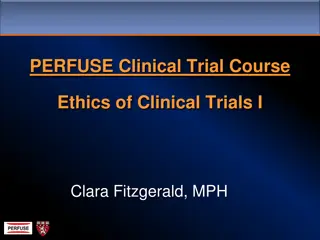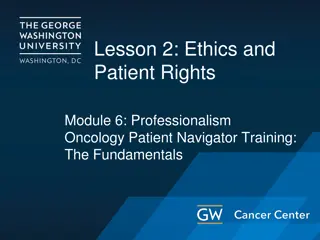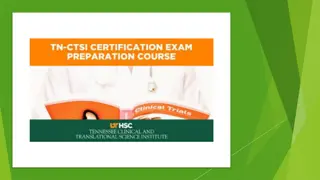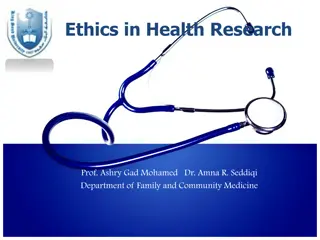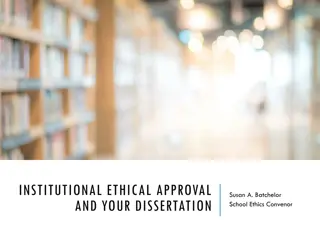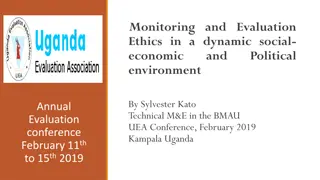Ethical Responsibilities in Legal Cases: Brady v. Maryland
Explore the case of Brady v. Maryland, focusing on the obligations of discovery in Texas criminal cases, including the constitutional aspect, the Michael Morton Act, and disciplinary rules. Delve into the critical issue of evidence suppression by the prosecution and its impact on due process rights.
Download Presentation

Please find below an Image/Link to download the presentation.
The content on the website is provided AS IS for your information and personal use only. It may not be sold, licensed, or shared on other websites without obtaining consent from the author. Download presentation by click this link. If you encounter any issues during the download, it is possible that the publisher has removed the file from their server.
E N D
Presentation Transcript
Ethical Responsibilities: Brady v. Maryland | the Michael Morton Act | Disciplinary Rules | Scientist s Duty to Correct
Presenters/Disclaimer Lynn Garcia General Counsel, Forensic Science Commission Carson Guy Research Attorney, Judge Barbara Hervey, Texas Court of Criminal Appeals *The views expressed by Carson Guy during this presentation are solely his, and they are not endorsed by the Texas Court of Criminal Appeals. This presentation is for informational purposes.
Three Sources of Discovery Obligations in Texas Criminal Cases Constitutional Brady v. Maryland, 373 U.S. 83 (1963). Statutory The Michael Morton Act (CCP art. 39.14, enacted in 2013) Rules Disciplinary Rules of Professional Conduct
Brady (cont.) A Maryland jury found John Brady and Charles Boblit guilty of first-degree murder. Brady said he participated in the preceding robbery, but not in the killing. At sentencing, both men received the death penalty.
Brady (cont.) After trial, Brady learned that Boblit previously confessed to the murder, but the prosecution suppressed that evidence for Brady s trial. On appeal, the Maryland Court of Appeals held that suppression of the confession denied Brady due process and remanded the case to reconsider the question of punishment only. A petition for a writ of certiorari was filed, which the United States Supreme Court granted.
Brady (cont.) [S]uppression by the prosecution of evidence favorable to an accused violates due process where the evidence is material either to guilt or punishment, irrespective of the good faith or bad faith of the prosecution.
Brady (cont.) [S]uppression by the prosecution of evidence favorable to an accused violates due process where the evidence is material either to guilt or punishment, irrespective of the good faith or bad faith of the prosecution.
Brady (cont.) Suppression The prosecution Evidence favorable to the accused Materiality
Brady (cont.) Suppression
Brady (cont.) To show that evidence was suppressed, the applicant must show that the State failed to disclose evidence which had been known to the prosecution but unknown to the defense.
Brady (cont.) The Prosecution
Brady (cont.) The prosecution for purposes of Brady includes, in addition to the prosecutor, other lawyers and employees in his office and members of law enforcement connected to the investigation and prosecution of the case. Though the CCA has not directly addressed it, many courts have considered crime labs to be part of the prosecution team.
Brady (cont.) Evidence Favorable to the Accused
Brady (cont.) Favorable evidence is that which, if disclosed and used effectively, may make the difference between conviction and acquittal.
Brady (cont.) Favorable evidence includes exculpatory evidence and impeachment evidence. Exculpatory evidence is that which may justify, excuse, or clear the defendant from fault. Impeachment evidence is that which disputes, disparages, denies, or contradicts other evidence.
Brady (cont.) Examples of Exculpatory Evidence Alibi showing that the defendant was in a different place when the crime was committed A video showing that the perpetrator of a bank robbery looked nothing like the defendant Possibly investigative notes Some DNA results (e.g., Michael Morton)
Brady (cont.) Examples of Impeachment Evidence Bad acts of a witness Pending charges against a witness Deals with prosecutor in exchange for testimony Prior inconsistent statements of a witness
Brady (cont.) Materiality
Brady (cont.) Suppressed evidence is material if there is a reasonable probability that the result of the trial would have been different if the suppressed evidence had been disclosed to the defense.
Brady (cont.) A reasonable probability is one sufficient to undermine confidence in the outcome of the trial.
Brady (cont.) When assessing materiality, the suppressed evidence is considered collectively, not item-by- item.
Brady (cont.) Who decides whether suppressed evidence is material? THE COURTS (ultimately the COURT OF CRIMINAL APPEALS)
Brady (cont.) The proper remedy for a Brady violation is a new trial. Risk mitigation is important because the cost to the criminal justice system is high.
Brady (cont.) Evolution of Brady Rule Defendant does not have to request Brady material. The State has a constitutional duty to produce it. The State has a duty to discover Brady material. Applies to favorable information, not just evidence. Favorable information includes information that might lead to evidence.
The Michael Morton Act Michael Morton was convicted of murder for killing his wife in 1987. He spent almost 25 years in prison before being exonerated by DNA evidence. The evidence pointed to the crime being committed by another individual. Morton was released from prison in 2011. In 2013, Mark Alan Norwood, was convicted of murder for killing Morton s wife. The prosecutor in the case, Ken Anderson, found to have withheld evidence after the judge had ordered its release to the defense.
The Michael Morton Act The Michael Morton Act was signed into law in May 2013 by Gov. Rick Perry and took effect in 2014. It requires prompt and broad disclosure of information held by the prosecution in criminal cases and was designed to formalize and regularize the process of criminal discovery throughout the state.
The Michael Morton Act Upon request by the defendant, the State must: Produce for copying and inspection everything in pretrial discovery Create an inventory of information produced (Both parties) acknowledge information was produced
The Michael Morton Act Statutory Brady-like rule. Notwithstanding any other provision of this article, the state shall disclose to the defendant any exculpatory, impeachment, or mitigating document, item, or information in the possession, custody, or control of the state that tends to negate the guilt of the defendant or would tend to reduce the punishment for the offense charged. *There is no mention of materiality in Art. 39.14(h).
The Michael Morton Act Continuing Disclosure Requirement If at any time before, during, or after trial the state discovers any additional document, item, or information required to be disclosed under Subsection (h), the state shall promptly disclose the existence of the document, item, or information to the defendant or the court.
Risk Management for Forensic Records Everything in the file may be discoverable by the defendant. If something in the lab s file turns out to be exculpatory (as determined by the courts), that information is imputed to the prosecutor whether she knows about it or not. To mitigate risk, attorneys should ask labs to provide bench notes, raw data, and other documentation, not just the lab report. Any information produced should be documented.
Disciplinary Rules of Prof. Conduct Rule 3.09(d) The prosecutor in a criminal case shall: (d) make timely disclosure to the defense of all evidence or information known to the prosecutor that tends to negate the guilt of the accused or mitigates the offense, and, in connection with sentencing, disclose to the defense and to the tribunal all unprivileged mitigating information known to the prosecutor, except when the prosecutor is relieved of this responsibility by a protective order of the tribunal
Texas Disciplinary Rules of Professional Conduct Brady is primarily focused on the potential harm to the defendant resulting from nondisclosure. The rule sets a higher level of conduct prosecutors must adhere to, rather than the minimal acceptable standard of behavior necessary to avoid a due process violation. Rule 3.09(d) requires a showing (and Brady does not) that the prosecutor had actual knowledge of the evidence that was suppressed. There is no materiality requirement.
Schultz Schultz v. Commission for Lawyer Discipline
Schultz Silvano Uriostegui was prosecuted for aggravated assault with a deadly weapon. The victim was attacked and stabbed in her apartment bedroom at night. The only light in the area was from a TV in another room. The victim told the police that Silvano had attacked her and testified to it in a hearing for a protective order. During a later interview, the victim said that she thought that her attacker was Silvano based on his smell, the sole of his boot, and his stature as she saw him in the shadowy light, but she admitted, I couldn t see his face. Assistant District Attorney Schultz did not disclose the victim s statement to the defense, although he began investigating another suspect.
Schultz Schultz argued that the statement was not exculpatory and was, at most, a prior inconsistent statement. The trial court granted a new trial. The District Attorney s Office sent a letter to the State Bar of Texas to report Schultz s conduct, although it excused the failure to disclose as unintentional. Defense counsel obtained the letter, then filed a grievance against Schultz with the State Bar, which resulted in a disciplinary proceeding before Evidentiary Panel 14-3 for the State Bar of Texas District 14 Grievance Committee.
Schultz The evidentiary panel determined that Schultz s failure to disclose the information concerning the victim s indirect and limited identification of Silvano violated Rule 3.09(d) and Rule 3.04(a). It imposed a six-month, fully probated suspension of Schultz s bar license. Schultz appealed the evidentiary panel s decision to the BODA to challenge the panel s findings of misconduct, though he completed the six-month probation prior to submitting his appeal.
Schultz Rule 3.04(a) A lawyer shall not: (a) unlawfully obstruct another party's access to evidence; in anticipation of a dispute unlawfully alter, destroy or conceal a document or other material that a competent lawyer would believe has potential or actual evidentiary value; or counsel or assist another person to do any such act.
Schultz Takeaways Rule 3.09(d) has no materiality requirement. Unlike Brady, Rule 3.09(d) is specifically intended to advise and prevent a prosecutor from making an incorrect judgment call regarding the materiality or admissibility of favorable information and evidence. Rule 3.09(d) requires the prosecution to disclose favorable information and evidence without regard for the anticipated impact of the information on the outcome of a trial.
Schultz Rule 3.09(d) has no admissibility requirement. Rule 3.09(d) requires disclosure prior to entering a plea of guilty. The ethical obligation s usefulness to the defense in plea bargaining is a key difference from the duty under Brady. Rule 3.09(d) attaches only when the prosecutor has actual knowledge. Actual knowledge may be inferred from circumstances. Constructive knowledge doctrine from Brady does not apply.
Schultz Failure to disclose can be unintentional, negligent, or in good faith. [A] lawyer need only be negligent to violate Rule [3.04]. A lawyer need not have known of the evidentiary value of the materials or even [have] recklessly disregarded the possibility that they might have such value, if a competent lawyer would have recognized that fact. Thus, under this rule, a lawyer cannot escape liability by closing his eyes to what he saw and could readily understand.
Schultz Article 39.14(h) mandates the same standard for disclosure as Rule 3.09(d) and, like Rule 3.09(d), disclosure does not depend upon the prosecution s subjective determinations of materiality and admissibility.
Forensic Code of Professional Responsibility & the Scientist s Duty to Correct
FORENSIC ANALYST CODE OF PROFESSIONAL RESPONSIBILITY 37 Texas Administrative Code Section 651.219 (b) (effective May 2018) Each forensic analyst shall: (1) Accurately represent his/her education training, experience, and areas of expertise. (2) Commit to continuous learning in the forensic disciplines and stay abreast of new findings, equipment and techniques to maintain professional competency.
FORENSIC ANALYST CODE OF PROFESSIONAL RESPONSIBILITY (3) Promote validation and incorporation of new technologies, guarding against the use of non-valid methods in casework and the misapplication of validated methods. (4) Avoid tampering, adulteration, loss, or unnecessary consumption of evidentiary materials. (5) Avoid participation in any case where there are personal, financial, employment-related or other conflicts of interest.
FORENSIC ANALYST CODE OF PROFESSIONAL RESPONSIBILITY (6) Conduct thorough, fair and unbiased examinations, leading to independent, impartial, and objective opinions and conclusions. (7) Make and retain full, contemporaneous, clear and accurate written records of all examinations and tests conducted and conclusions drawn, in sufficient detail to allow meaningful review and assessment by an independent person competent in the field. (8) Base conclusions on procedures supported by sufficient data, standards and controls, not on political pressure or other outside influence.
FORENSIC ANALYST CODE OF PROFESSIONAL RESPONSIBILITY (9) Not offer opinions or conclusions that are outside one s expertise. (10) Prepare reports in clear terms, distinguishing data from interpretations and opinions, and disclosing any relevant limitations to guard against making invalid inferences or misleading the judge or jury. (11) Not issue reports or other records or withhold information from reports for strategic or tactical litigation advantage.
FORENSIC ANALYST CODE OF PROFESSIONAL RESPONSIBILITY (12) Present accurate and complete data in reports, oral and written presentations and testimony based on good scientific practices and valid methods. (13) Testify in a manner which is clear, straightforward and objective, and avoid phrasing testimony in an ambiguous, biased or misleading manner. (14) Retain any record, item or object related to a case, such as work notes, data, and peer or technical review information due to potential evidentiary value and pursuant to the laboratory s retention policy.
FORENSIC ANALYST CODE OF PROFESSIONAL RESPONSIBILITY (15) Communicate honestly and fully with all parties (investigators, prosecutors, defense attorneys, and other expert witnesses), unless prohibited by law. (16) Document and notify management or quality assurance personnel of adverse events, such as an unintended mistake or breach of ethical, legal, scientific standards, or questionable conduct. (17) Ensure reporting, through proper management channels, to all impacted scientific and legal parties of any adverse event that affects a previously issued report or testimony.
CRIME LAB MANAGEMENT CODE OF PROFESSIONAL RESPONSIBILITY (1) Encourage a quality-focused culture that embraces transparency, accountability, and continuing education while resisting individual blame or scapegoating. (2) Provide opportunities for forensic analysts to stay abreast of new scientific findings, technology and techniques while guarding against the use of non-valid methods in casework, the misapplication of validated methods or improper testimony regarding a particular analytical method or result.


